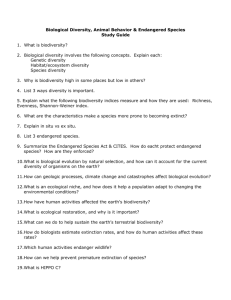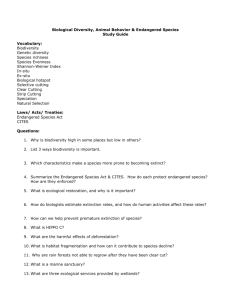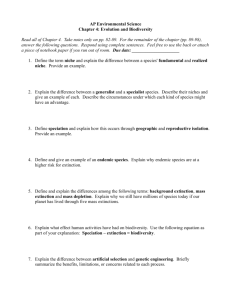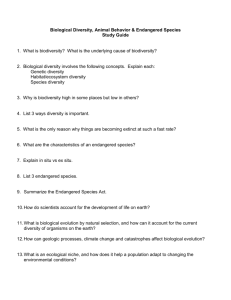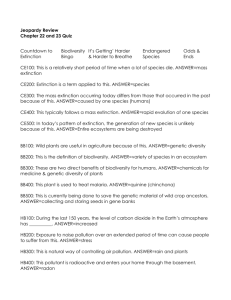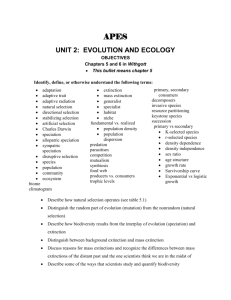apes-area7c-biodiversity_loss
advertisement
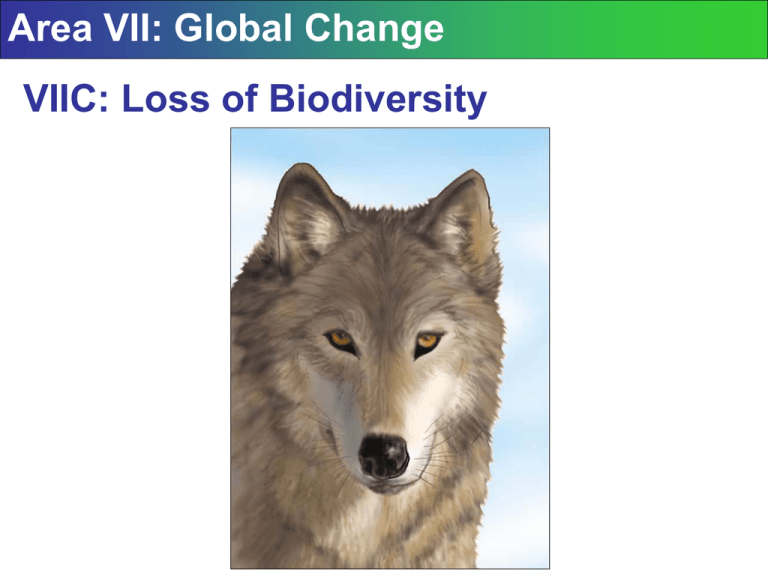
Area VII: Global Change VIIC: Loss of Biodiversity 11-1 Human impacts on terrestrial biodiversity Humans have degraded much of the Earth most temperate and tropical ecosystems (except deserts) have been disturbed by humans in U.S. 95% of virgin forests have been cut, and 98% of tallgrass prairie has disappeared biodiversity has intrinsic (existence) and extrinsic (instrumental, use) value Fig. 11-2 Factors affecting biodiversity Biodiversity Increase Factors Decrease Factors •Middle stages of succession •Extreme environmental conditions •Moderate environmental disturbance •Large environmental disturbance •Small changes in environmental conditions •Intense environmental stress •Physically diverse habitat •Severe shortages of key resources •Evolution •Nonnative species introduction •Geographic isolation Fig. 11-3 Human affects on biodiversity Human Population Size and resource use Human Activities Agriculture, industry, economic production and consumption, recreation Direct Effects Degradation and destruction of natural ecosystems Changes in number and distribution of species Alteration of natural chemical cycles and energy flows Pollution of air, water, and soil Indirect Effects Loss of Climate biodiversity change Fig. 11-4 Future of biodiversity Arctic Circle 60° EUROPE NORTH AMERICA 30°N Tropic of Cancer Pacific Ocean 0° 150° 120° 90° Tropic of Capricorn ASIA Atlantic Ocean AFRICA 30°W SOUTH AMERICA 0° Pacific Ocean 60°E 90° 150° Indian AUSTRALIA Ocean 30°S Antarctic Circle 60° ANTARCTICA Critical and endangered Projected Status of Biodiversity 1998–2018 Threatened Stable or intact 13-2 Human impacts on aquatic biodiversity Humans threats to aquatic biodiversity ~75% of the commercially valuable marine fish species are either overfished or fished to their sustainable limits overfishing leads to commercial extinction big fish of commercially valuable species are becoming scarce during the last 45 years, the abundance of large, open-ocean dwelling fish has plummeted by 90% 13-2 Human impacts on aquatic biodiversity overfishing, cont. 230 populations of marine fish suffered an 83% drop in breeding population size from known historic levels destruction of habitat can prevent recovery the fishing industry has begun to take fastergrowing varieties at lower trophic levels because of the fishing methods, almost 33% of the fish caught are bycatch (dead or dying unwanted fish thrown overboard) Fig. 13-2 Marine biodiversity Fig. 13-3 Freshwater biodiversity 12-2 Importance of Wild Species Wild species have value If species evolve, then why does it matter that some go extinct? What’s the big deal? evolution takes a long time species are useful to us economic value ecological value genetic value aesthetic value medicinal value recreational value photography, bird watching, ecotourism some benefits have not yet been identified 12-1 Species Extinction There are three types of species extinction local extinction: species no longer found in one area but present in others ecological extinction: species can no longer play its ecological role because so few are left biological extinction: species is no longer found anywhere on Earth Fig. 12-2 Some extinct species 12-1 Species Extinction Species are classified according to their risk species heading toward biological extinction are either endangered or threatened endangered species: species has few remaining individuals and could become extinct over all or most(?) of its range threatened species: species is abundant, but declining numbers make it likely to become endangered in the near future the first species to go tend to be economically valuable ones Fig. 12-3a Some endangered species Grizzly bear (threatened) Kirtland's warbler White top pitcher plant Arabian oryx (Middle East) African elephant (Africa) Mojave desert tortoise (threatened) Swallowtail butterfly Humpback chub Golden lion tamarin (Brazil) Siberian tiger (Siberia) Fig. 12-3b Some endangered species West Virginia Giant panda spring salamander (China) Mountain gorilla (Africa) Pine barrens tree frog (male) Whooping crane Knowlton cactus Swamp pink Hawksbill sea turtle Blue whale El Segundo blue butterfly Fig. 12-3c Some endangered species Florida manatee Northern spotted Gray wolf owl (threatened) Florida panther Bannerman's turaco (Africa) Devil's hole pupfish Black-footed Snow leopard Symphonia (Central Asia) (Madagascar) ferret Ghost bat (Australia) California condor Black lace cactus Utah prairie dog (threatened) Black rhinocerosOahu tree snail (Africa) 12-1 Species Extinction International Union for Conservation of Nature and Natural Resources (IUCN-in your book “World Conservation Union”) is a leading authority on species conservation IUCN categories as seen on Wikipedia: Fig. 12-4 Characteristics of prone species Fig. 12-5 Percent of species at risk by type Percent of species at risk-IUCN Red List 07 Percent of birds at risk-IUCN(?) Red List 08 12-1 Species Extinction Biologists try to estimate extinction rates recall the terms background extinction and mass extinction estimating current extinction rate is difficult for several reasons 1. extinction takes a while 2. we have not identified every species 3. we know little about species we have identified 12-1 Species Extinction IUCN monitors species (such as changes in number or distribution) so that patterns can be detected category of every species ideally re-assessed every 5 years (Wikipedia) species-area relationship can be used to estimate extinction rates based on observations of the correlation between number of species and the size of an area where they are found Number of species per unit area 12-1 Species Extinction Humans are increasing the extinction rate the extinction rate has increased since the arrival of humans 1,000 to 10,000 times higher extinction rate of 0.1% to 1% per year number of species going extinct (based on these percentages) depends on number of species in the world 12-1 Species Extinction extinction rate of 0.1% to 1% per year might be conservative 1. rate likely to increase this century 2. some areas (hot spots) have much higher extinction rates 3. we limit speciation by degrading biologically diverse environments (?) the rate could be too high because it is based on inadequate data and sampling either way, more research is needed 13-2 Human impacts on aquatic biodiversity fish are more threatened with extinction by humans than any other group of species freshwater species are disappearing 5x faster than land animals Fig. 13-4 Mean trophic levels of fish catch 12-3 Extinction Threats-Habitat Loss Habitat loss and degradation are the greatest threats to species 12-3 Extinction Threats-Habitat Loss secondary factors: habitat destruction and fragmentation major habitat disturbance factors: agriculture commercial development water development outdoor recreation livestock grazing and pollution invasive species pollution overharvesting Fig. 12-7a Effect of habitat loss Range 100 years ago Range today (about 2,300 left) Indian Tiger Fig. 12-7b Effect of habitat loss Range in 1700 Range today (about 2,400 left) Black Rhino Fig. 12-7c Effect of habitat loss Probable range 1600 Range today (300,000 left) African Elephant Fig. 12-7d Effect of habitat loss Former range Range today (34,000–54,000 left) Asian or Indian Elephant 12-3 Extinction Threats-Habitat Loss loss of terrestrial species is greatest in: 1. tropical forests (deforestation) 2. wetlands (filling) 3. grasslands (plowing) 4. islands (island biogeography can help us understand the effects of habitat fragmentation) 12-3 Extinction Threats-Habitat Loss birds are in decline 70% of bird species are declining in numbers causes: 1. habitat loss and fragmentation 2. nonnative species (cats, rats, snakes, mongooses, other birds) 3. pet trade (parrots) 4. human structures (fishing lines, phone lines, buildings, etc.) 5. pollution Fig. 12-8 Threatened U.S. songbirds Cerulean warbler Florida scrub jay Sprague’s pipit Bichnell’s thrush California gnatcatcher Kirtland’s warbler Blacked-capped vireo Golden-cheeked warbler Henslow’s sparrow Bachman’s warbler 13-2 Human impacts on aquatic biodiversity aquatic species are also threatened ~50% of world’s coastal wetlands were lost in the last century coral reefs are severely damaged, mostly by human activities >33% of mangrove swamps have disappeared because of clearing for development, crops, and aquaculture dredging and trawling are destroying many bottom habitats scientists signed a statement to urge the UN to ban bottom trawling on the high seas 12-4 Extinction Threats-Nonnative species Nonnative species can be beneficial, detrimental, or both we use nonnative species for food, medicine, enjoyment (pets) nonnative species can displace or cause the extinction of native species no predators introduce new diseases grow faster result: they decrease biodiversity Fig. 12-9a Deliberately introduced species Purple looselife European starling African honeybee (“Killer bee”) Marine toad Water hyacinth Japanese beetle Nutria Salt cedar (Tamarisk) Hydrilla European wild boar (Feral pig) Fig. 12-9b Accidently introduced species Sea lamprey (attached to lake trout) Argentina fire ant Brown tree snake Eurasian muffle Common pigeon (Rock dove) Formosan termite Zebra mussel Asian long-horned beetle Asian tiger mosquito Gypsy moth larvae Fig. 12-11 Argentina fire ant range 1918 2000 12-4 Extinction Threats-Nonnative species prevention is the best way to reduce threats from invasive species difficulties: small hard to detect breed rapidly Fig. 12-12 Invaders and ecosystems 13-2 Human impacts on aquatic biodiversity nonnative species are an increasing threat to marine and freshwater biodiversity nonnative aquatic species arrive in ship ballast water can be lessened by requiring ships to: discharge ballast water and replace it with saltwater at sea before entering ports, sterilize ballast water, or pump nitrogen into it 13-2 Human impacts on aquatic biodiversity nonnative species are an increasing threat to marine and freshwater biodiversity case study: purple loosestrife is a perennial plant that has invaded wetlands and greatly reduced biodiversity two natural predators of loosestrife have been introduced from Europe where loosestrife is native it will take time to determine whether this biological control approach works without the predators becoming pests Fig. 13-5 Distribution of purple loosestrife 12-5 Extinction Threats-Poaching Poaching is highly profitable huge profits and few penalties encourage poaching (illegal killing or taking of wildlife) hunting (for food) can threaten wild species when it is done for export as opposed to subsistence increasing due to: (1) increasing population (2) accessibility to forests (3) restaurant demand (4) high profits 12-6 Other Extinction Threats Killing predators, acquiring exotic pets and plants, and climate change and pollution affect ecosystems predators are killed because they bother us or cause economic losses Carolina parakeet (eat fruit) elephants (trample) coyotes, wolves, bobcats (eat livestock or poultry, popular game, or fish in farms) prairie dogs (make holes (not predator)) 11-2 Conservation Biology Humans have degraded much of the Earth conservation biology aims to analyze and protect Earth’s biodiversity bioinformatics is the applied science of managing, analyzing, and communicating biological information species cataloging DNA analysis species ranges Fig. 11-5 Protecting biodiversity The Species Approach Goal Protect species from premature extinction Strategies • Identify endangered species • Protect their critical habitats Tactics • Legally protect endangered species • Manage habitat • Propagate endangered species in captivity • Reintroduce species into suitable habitats The Ecosystem Approach Goal Protect populations of species in their natural habitats Strategy Preserve sufficient areas of habitats in different biomes and aquatic systems Tactics • Protect habitat areas through private purchase or government action • Eliminate or reduce populations of alien species from protected areas • Manage protected areas to sustain native species • Restore degraded ecosystems 12-8 Protecting Wild Species: Sanctuary Wildlife refuges can help protect species wildlife refuges set aside land for species gene banks (or seed banks), botanical gardens, farms, zoos, and aquariums can help preserve species important for education minimize need for wild species (farms) limited effectiveness Fig. 12-15 Major migratory flyways 12-9 Reconciliation Ecology Reconciliation ecology is a new form of conservation reconciliation ecology involves inventing, establishing, and maintaining new habitats for species conservation in the areas where humans live and work Fig. 12-16 Preventing premature extinction 12-7 Protecting Wild Species: Legal Treaties and laws can help protect species international treaties 1975 Convention on International Trade in Endangered Species (CITES) protects many species from commercial trade limited effectiveness enforcement is difficult enforcement varies allows exemptions 12-7 Protecting Wild Species: Legal Treaties and laws can help protect species international treaties Convention on Biological Diversity 1992 signatory nations agree to inventory biodiversity and develop a plan to protect it U.S. has not ratified it no enforcement 12-7 Protecting Wild Species: Legal national laws Lacey Act of 1900 requires federal permit to transport live or dead wild animals across state borders Endangered Species Act of 1973 (ESA) identifies and legally protects endangered species (currently about 1260 species) NMFS and USFWS list species forbids sale and purchase of any product made from endangered species (including foreign species) forbids federal agencies from harming endangered species or their habitats 12-7 Protecting Wild Species: Legal national laws, cont. Endangered Species Act of 1973, cont. requires protection of critical habitat some habitats have not been protected due to political pressure and lack of funds controversial private versus public property rights issues examples two types of freedoms: protection from others, do what you want without government interference 12-7 Protecting Wild Species: Legal national laws, cont. Endangered Species Act of 1973, cont. applies to private land steep fines and imprisonment for violations incentives for private land owners habitat conservation plans (HCPs) can help safe harbor agreements voluntary candidate conservation agreements 12-7 Protecting Wild Species: Legal national laws, cont. Endangered Species Act of 1973, cont. The National Academy of Sciences recommended three major changes in order to make the ESA more scientifically sound and effective 1. greatly increase funding to implement the act 2. develop recovery plans more quickly 3. when a species is first listed, establish a core of its survival habitat that could support the species for 25–50 years Fig. 12-14 Biodiversity hot spots in U.S. 13-3 Protecting and Sustaining Marine Bio. Protection of marine life is difficult protecting marine biodiversity is difficult: coastal development large inputs of sediment, nutrients, and pollution damage not visible to most people lack of knowledge about ocean; view that ocean is inexhaustible most of the ocean is outside the legal jurisdiction of any country (resulting in tragedy of the commons) Fig. 13-6 Threatened marine mammals 13-3 Protecting and Sustaining Marine Bio. Laws, treaties, and education can help three sea turtle species are endangered loss of onshore habitat taking of eggs used as food, medicine, jewelry, etc. unintentional catching 1000’s globally from long-line fishing 1000’s from U.S. shrimp trawling reduced by turtle exclusion devices since 1989 Fig. 13-7 Major species of sea turtles 13-3 Protecting and Sustaining Marine Bio. Laws, treaties, and education can help Convention on International Trade in Endangered Species (1975) (CITES) Global Treaty on Migratory Species (1979) U.S. Marine Mammal Protection Act (1972) U.S. Endangered Species Act (1973) U.S. Whale Conservation and Protection Act (1976) International Convention on Biological Diversity (1995) Fig. 13-8a Toothed whales Fig. 13-8b Baleen whales 13-3 Protecting and Sustaining Marine Bio. Some countries want to overturn the 1970 whaling ban International Whaling Commission (IWC) est. 1946 (now has 49 member nations) established quotes for whaling did not work because quotas based on inadequate data or ignored no powers of enforcement U.S. banned all commercial whaling and imports of whale products in 1970 13-3 Protecting and Sustaining Marine Bio. Some countries want to overturn the 1970 whaling ban U.S. and many nonwhaling countries in IWC imposed a moratorium on commercial whaling in 1986 42.5 k killed in 1970, 1.2 k in 2004 Japan, Norway, and Iceland still hunt whales traditional “moratorium based on emotion, not science” why not if there are over 1 M whales? 13-3 Protecting and Sustaining Marine Bio. Some countries want to overturn the 1970 whaling ban some conservationists disagree “whales are peaceful” “whales are intelligent” “whales are sensitive” “whales are social” inaccuracy of estimates limited whaling will open the door to approval and weaker laws 13-3 Protecting and Sustaining Marine Bio. Some marine sanctuaries exist but not many national control of oceans sovereignty to 12 miles offshore (U.N. Law of the Sea) jurisdiction to 200 miles offshore (Exclusive Economic Zone (EEZ)) not much of that area (36% of ocean surface and 90% of fish stocks) is protected IUCN has helped establish marine protected areas (MPAs) since 1986 13-3 Protecting and Sustaining Marine Bio. Other solutions integrated coastal management zone land and sea portions of an entire coastal area reconciliation ecology 13-5 Protecting, Sustaining, and Restoring Wetlands Coastal and inland wetlands are important reservoirs of aquatic biodiversity; they provide ecological and economic services a law that requires a permit to fill or deposit dredges into wetlands has cut wetland loss by 80% between 1969 and 2002 13-5 Protecting, Sustaining, and Restoring Wetlands a study by the National Academy of Sciences found that mitigation banking, the destruction of a wetland as long as an equal area of the same type is created or restored, does not work very well; these projects often fail to meet the standards set for them Fig. 13-10 Solutions Protecting Wetlands Legally protect existing wetlands Steer development away from existing wetlands Use mitigation banking only as a last resort Require creation and evaluation of a new wetland before destroying an existing wetland Restore degraded wetlands Try to prevent and control invasions by nonnative species 13-5 Protecting, Sustaining, and Restoring Wetlands case study: Everglades natural Everglades are half their original size and are drying out, leaving them vulnerable to fire and invasion by nonnative species Everglades NP was set up in the lower part of the Everglades, but water did not flow into it and human activity caused disturbances 90% of the wading birds are gone, and other vertebrates are reduced in number by 75–95% Florida Bay has become saltier and warmer loss of water flow and input from crop fields and cities have caused large algal blooms harm coral reefs, tourist industry 13-5 Protecting, Sustaining, and Restoring Wetlands case study: Everglades, cont. the U.S. Army Corp of Engineers has begun a restoration project funded by the state and the federal government to restore the river and flow of water to the Everglades; goals: restore curving flow of more than half of the Kissimmee River remove 250 miles of canals and levees south of Lake Okeechobee buy 93 square miles of farmland and allow it to flood to create artificial marshes create a network of artificial marshes 13-5 Protecting, Sustaining, and Restoring Wetlands case study: Everglades, cont. project goals, cont. create 18 large reservoirs to ensure water for south Florida’s present and future population and the lower Everglades build new canals, reservoirs, and pumping stations to capture and return to the Everglades 80% of the water flowing out to sea Fig. 13-11 Kissimm ee River Channeliz ed) Unchanneliz ( ed) ( FLORID A Fort Myers GULF OF MEXIC O Lake Okeechob ee West Palm Beac h Naple s Fort Lauderda le Agricultural area Treatment marsh Water conservation Can area al Everglad es National Park FLORID A Area of detail Florida Bay 20 0 0 20 40 Mia mi ATLANTI C OCEAN Key Largo 40 60 miles 60 kilometers 13-6 Protecting, Sustaining, and Restoring Lakes and Rivers invasions by nonnative species have upset the ecological functioning of the Great Lakes for decades at least 162 nonnative species have invaded the Great Lakes since the 1920s sea lampreys have depleted a number of the sport fish species in the lakes 13-6 Protecting, Sustaining, and Restoring Lakes and Rivers nonnative species in Great Lakes, cont. zebra mussels were brought into the lakes in ballast water very aggressive pests (no known natural enemies) displaced native mussel species clogged pipes and piers fouled beaches spread to other parts of the U.S. 13-6 Protecting, Sustaining, and Restoring Lakes and Rivers rivers/streams are important ecological and economic resources degraded by overfishing, pollution, dams, and water withdrawal case study: salmon in Columbia River salmon are migratory fish that breed in the upper reaches of the river and its tributaries need free flowing water to return, spawn, and lay eggs where they hatched benefit nearby forest as fertilizer as bears eat and discard carcasses on the forest floor trees grow up to 3x faster along streams 13-6 Protecting, Sustaining, and Restoring Lakes and Rivers case study: Columbia River, cont. threats to salmon: many dams on Columbia River overfishing in the Pacific Ocean destruction of spawning grounds by sediment and lack of trees (makes water too warm for eggs) water withdrawal release of farm raised salmon (could decrease genetic diversity) result: 94% drop of wild Pacific salmon, and nine species of Pacific Northwest salmon are endangered or threatened Fig. 13-13 Fig. 13-14 Human capture Fish change form Fish enter rivers and head for spawning areas To hatchery Salmon processi ng plant In the fall spawning salmon deposit eggs in gravel nests and die Modifi ed Life Cycle Eggs are taken from Grow to maturity in Pacific Ocean Norm in 1-2 years Fry hatch in the spring... al Life Cycle Grow to smolt and enter the ocean... Fingerlings migrate downstream adult females and fertilized with sperm “milked” from males Eggs and young are cared for in the hatchery And grow in the stream for 1-2 years Fingerlings are released into river 13-6 Protecting, Sustaining, and Restoring Lakes and Rivers case study: Columbia River, cont. solutions: The Northwest Power Act was passed in 1980; goals: meeting electricity needs of the region restoring salmon, other fish populations these two goals often conflict people are working together to try to solve the conflicts in this large-scale reconciliation project critics say that the wild salmon populations are stable in Alaska, so we should not worry about the wild salmon of the Pacific Northwest Fig. 13-15 Solutions Rebuilding Salmon Populations Building upstream hatcheries Releasing juvenile salmon from hatcheries to underpopulated streams Releasing extra water from dams to wash juvenile salmon downstream Building fish ladders so adult salmon can bypass dams during upstream migration Using trucks and barges to transport salmon around dams Reducing silt runoff from logging roads above salmon spawning streams Banning dams from some stream areas 13-6 Protecting, Sustaining, and Restoring Lakes and Rivers sustainable management of freshwater fish involves encouraging populations of commercial/sport fish species, preventing overfishing, and reducing or eliminating less desirable fish populations 1. regulate fishing seasons and the number and size of fish taken 2. improve habitats, breed genetically resistant fish varieties, and use judicious amounts of antibiotics and disinfectants to control predators, parasites, and diseases are methods suggested 3. some individuals have worked to restore 13-6 Protecting, Sustaining, and Restoring Lakes and Rivers the National Wild and Scenic Rivers Act was passed in 1968 to protect rivers and river segments with outstanding scenic, recreational, geological, wildlife, historical, or cultural values Congress established a three-tiered classification scheme wild rivers are relatively inaccessible; they are not permitted to be widened, straightened, dredged, filled, or dammed scenic rivers are free from dams, mostly undeveloped, of great scenic value, and accessible in some places by roads 13-6 Protecting, Sustaining, and Restoring Lakes and Rivers the National Wild and Scenic Rivers Act, cont. classification, cont. recreational rivers are readily accessible by roads and may have some dams or development along their shores only 0.2% of the 3.5 million miles of rivers are protected under the Act, and 17% of the total river length has dams and reservoirs on them environmentalists want to add 1,500 additional river segments for a total of 2% of the total river systems; there is opposition 13-6 Protecting, Sustaining, and Restoring Lakes and Rivers threats to aquatic biodiversity are real and growing we must greatly increase research and expand efforts to protect and restore aquatic biodiversity and promote integrated ecological management Fig. 13-12 Natural Capital Ecological Services of Rivers •Deliver nutrients to sea to help sustain coastal fisheries •Deposit silt that maintains details •Purify water •Renew and renourish wetlands •Provide habitats for wildlife



